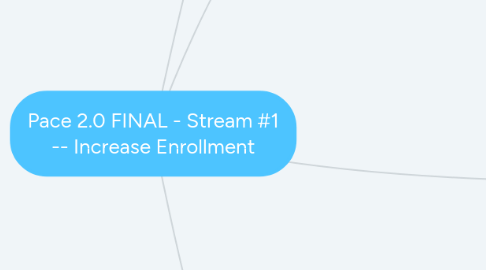
1. Streamline Enrollment
1.1. Enrollment
1.1.1. •Undertake process improvement analysis for enrollment-- (e.g. rapid results institute)
1.1.2. •Utilize designated enrollment team
1.1.3. •Clarify ownership of enrollment decision and process (e.g. circuit breaker idea)
1.1.4. •Provide interim services while waiting enrollment eligibility confirmation
1.1.5. •Work with state to minimize length of eligibility service process
1.1.6. •Hire eligibility specialist to assist with medicaid eligibility
1.2. Disenrollment
1.2.1. •Create a dis-enrollment team that is both preventive and reactive
1.3. Metrics
1.3.1. •Create a dashboard of metrics for enrollment and retention (process and outcome)
2. Increase Pipeline for Enrollment
2.1. Partnerships
2.1.1. •Identify community based organizations that specialize in specific sub-populations for referrals
2.1.2. •Compare the differences in referrals across different PACE organizations. Study referral patterns.
2.1.3. •Understand the market potential for your specific PACE organization at a granular level (in specific communities / geographies)
2.1.4. •Set tactics for number of calls/visits for marketing/intake staff and measure effectiveness
2.2. Public Awareness
2.2.1. •Create virtual PACE tour
2.2.2. •Create an information toolkit for promotion and education about PACE (talking points, virtual PACE tour, testimonials, participant stories)
2.2.3. •Brand PACE vans with PACE logo
2.3. Traditional Media
2.3.1. •Solicit earned media, especially for small market, rural centers (run stories, op-eds)
2.3.2. •Television and Radio Ads (make personal and warm)
2.3.3. •Direct mail campaigns
3. Building Readiness for Growth
3.1. Staff
3.1.1. •Increase HR capacity, with more needed during rapid growth and hiring.
3.1.2. •Proactive recruitment to maintain ratios
3.1.3. •Staff to provide real time data for action.
3.1.4. •Hire/contract a dedicated recruiter
3.2. Planning for Growth
3.2.1. •Assess the organizations readiness for rapid growth, e.g. with SWAT analysis.
3.2.2. •Develop a plan for growth and report to the Board
3.2.3. •Periodically revise organizational chart to accommodate growth
3.3. Systems
3.3.1. •Automate specific EHR system for PACE – for entire system of care
3.3.2. •Have a main number for the PACE center for all inquiries - which then sources the call to the right provider
3.3.3. •Transportation routing system/software
3.4. Space
3.4.1. •Anticipate CMS/State process for adding centers/sites
3.4.2. •Use ACS to manage overflow (temporary).
3.5. Managing Risk / Concern
3.5.1. •Refine the enrollment decision making process to build confidence in safety in the community
3.5.2. •Use a risk assessment tool (including SDOH) in managing the population
3.5.3. •Weekly UM meetings about participants at risk -- and we rank them
4. Aims and Leadership
4.1. Leadership
4.1.1. •Communicate plan to accommodate growth
4.1.2. •Undertake a leadership listening tour to frame the problem (numeric, logical, and emotional ways), solicit ideas, and increase involvement from team (person centered outcomes)
4.2. Aims
4.2.1. •Create aims / vital signs report card (balanced score card that includes clinical, financial, and enrollment measures)
4.3. Culture Change
4.3.1. •Generate diverse case studies -- showing successful enrollment in various settings. Show people what is possible. **
4.3.2. •Identify meaningful incentives (building in slack time, days off based on outcomes, $$ compensation)
4.3.3. •Translating growth into center outcomes
